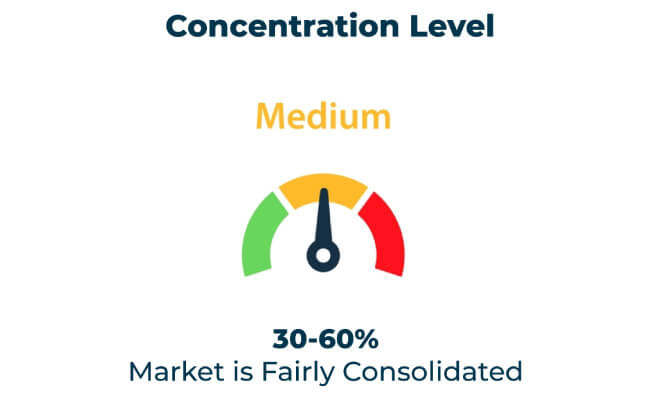Rising demand for premium, recyclable, and sustainable packaging solutions among beverage, food, cosmetics, and personal care industries largely contributes to the growth of retail glass packaging. It is expected to continue growing at a CAGR of 3.3% to reach USD 16.7 billion by 2035. Key growth drivers include advancements in glass manufacturing technologies, consumer demand for eco-friendly packaging, and regulatory support for restricted use of plastics.
Manufacturers are designing light-weight products, improving recyclability, and introducing new decoration concepts to support brand requirements. Cooperation with beverage, food manufacturers, and luxury brands is pushing market growth forward.
| Attribute | Details |
|---|---|
| Projected Value by 2035 | USD 16.7 billion |
| CAGR during the period 2025 to 2035 | 3.3% |
Explore FMI!
Book a free demo
Summary
This analysis covers the positioning of major players in the retail glass packaging market. It shows that Ardagh Glass Packaging leads with innovative and sustainable glass packaging solutions but challenges are faced in terms of the increasing energy cost. Owens-Illinois, or O-I, excels in lightweight and custom glass designs, but regional competition is a struggle.
Verallia focuses on recyclable and decorative glass packaging but faces difficulties in scaling its production. Opportunities lie in exploiting sustainability and exploiting emerging markets; threats include regulatory change and fluctuation in energy price.
Ardagh Glass Packaging
Ardagh Glass Packaging demonstrates strengths in its innovative use of recyclable materials and advanced glass manufacturing technologies. However, weaknesses lie in the rising costs of energy and raw materials. Opportunities include partnerships with global beverage and cosmetics brands to expand eco-friendly packaging solutions. Threats arise from increasing competition and evolving regulatory landscapes.
Owens-Illinois (O-I)
Owens-Illinois excels in lightweight and customizable glass packaging tailored for the food, beverage, and cosmetics industries. However, the company faces challenges due to regional competition and high operational costs. Automation and material advancements can reduce costs and increase efficiency. Threats include stricter environmental regulations and competition from alternative packaging solutions.
Verallia
Verallia’s strengths lie in its focus on decorative and recyclable glass packaging materials. However, its weaknesses include scalability challenges in emerging markets. Opportunities exist in expanding partnerships with premium and luxury brands. Threats stem from rising competition and regulatory compliance costs.
| Category | Market Share (%) |
|---|---|
| Top 3 Players (Ardagh Glass, Owens-Illinois, Verallia) | 19% |
| Rest of Top 5 Players | 06% |
| Next 5 of Top 10 Players | 12% |
Type of Player & Industry Share (%)
| Type of Player | Market Share (%) |
|---|---|
| Top 10 Players | 37% |
| Next 20 Players | 25% |
| Remaining Players | 38% |

Year-on-Year Leaders
North America and Europe enforce stringent regulations promoting the use of recyclable and eco-friendly materials. Asia-Pacific’s rapid industrialization and increasing consumer awareness of sustainability create significant opportunities.
Emerging markets in Africa, South America, and parts of Asia-Pacific present significant growth potential. Affordable and durable glass packaging is in demand to meet regulatory and consumer expectations.
In-House vs. Contract Manufacturing
Regional dynamics shape the retail glass packaging market. North America leads with sustainability and branding innovations. Europe emphasizes lightweight and decorative designs, while Asia-Pacific’s growing beverage and cosmetics markets drive demand. Emerging markets offer opportunities for affordable and durable solutions.
| Region | North America |
|---|---|
| Market Share (%) | 35% |
| Key Drivers | Advanced recycling and decorative innovations. |
| Region | Europe |
|---|---|
| Market Share (%) | 30% |
| Key Drivers | Focus on eco-friendly and premium designs. |
| Region | Asia-Pacific |
|---|---|
| Market Share (%) | 25% |
| Key Drivers | Growing beverage and cosmetics sectors. |
| Region | Other Regions |
|---|---|
| Market Share (%) | 10% |
| Key Drivers | Growth in emerging markets. |
The retail glass packaging market will expand through material innovations, automation, and strategic collaborations. Companies focusing on lightweight, decorative, and sustainable solutions will gain a competitive edge. Investment in recycling infrastructure will accelerate adoption.
|
Tier |
Key Companies |
|
Tier 1 |
Ardagh Glass Packaging, Owens-Illinois, Verallia |
|
Tier 2 |
Vidrala, Stoelzle Glass Group |
|
Tier 3 |
Hindusthan National Glass, Consol Glass |
The retail glass packaging market is poised for significant growth, driven by sustainability goals, consumer preferences for premium designs, and advancements in decorative technologies. Companies prioritizing eco-friendly, lightweight, and decorative solutions will secure leadership in this evolving market.
Key Definitions
Abbreviations
Research Methodology
This report is based on primary research, secondary data analysis, and market modeling. Insights were validated through industry expert consultations.
The retail glass packaging market includes recyclable, decorative, and premium packaging solutions designed for beverages, food, cosmetics, and personal care industries.
Increasing demand for premium, sustainable, and recyclable packaging solutions.
It is expected to continue growing at a CAGR of 3.3% to reach USD 16.7 billion by 2035.
Leading players include Ardagh Glass Packaging, Owens-Illinois, and Verallia.
Key challenges include rising material and energy costs, regulatory complexities, and fragility concerns.
Opportunities lie in lightweight materials, decorative innovations, and collaborations with luxury brands.
Nitrogen Flushing Machine Market Report – Trends, Size & Forecast 2025-2035
Pan Liner Market Insights – Demand, Growth & Industry Trends 2025-2035
Perfume Filling Machine Market Report – Trends, Demand & Industry Forecast 2025-2035
Molded Pulp Packaging Machines Market Analysis - Growth & Forecast 2025 to 2035
Packaging Tensioner Market Analysis - Growth & Forecast 2025 to 2035
Packaging Films Market Analysis by Product Type, Material Type and End Use Through 2035

Thank you!
You will receive an email from our Business Development Manager. Please be sure to check your SPAM/JUNK folder too.